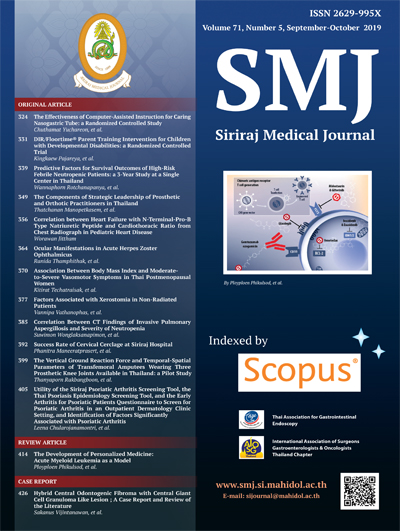Utility of the Siriraj Psoriatic Arthritis Screening Tool, the Thai Psoriasis Epidemiology Screening Tool, and the Early Arthritis for Psoriatic Patients Questionnaire to Screen for Psoriatic Arthritis in an Outpatient Dermatology Clinic Setting, and Identification of Factors Significantly Associated with Psoriatic Arthritis
DOI:
https://doi.org/10.33192/Smj.2019.61Keywords:
Factors associated with PsA; Psoriasis Epidemiology Screening Tool (PEST); screening tools for psoriatic arthritis; the Early Arthritis for Psoriatic Patients (EARP) questionnaire; the Siriraj Psoriatic Arthritis Screening Tool (SiPAT)Abstract
Objective: To assess the clinical utility of the Psoriasis Epidemiology Screening Tool (PEST), the Early Arthritis for Psoriatic Patients (EARP) questionnaire, and the Siriraj Psoriatic Arthritis Screening Tool (SiPAT) as screening tools for psoriatic arthritis (PsA), and to identify factors significantly associated with PsA.
Methods: This cross-sectional study included adult psoriasis patients who attended the outpatient clinic at Siriraj Hospital and had not been diagnosed with PsA during 1 March 2017 to 28 February 2018. Participants completed the EARP, PEST, and SiPAT, after which musculoskeletal history was taken, and examination and radiography were performed. Diagnosis of PsA was based on Classification Criteria for Psoriatic Arthritis. Receiver operator characteristic (ROC) curves, sensitivity, and specificity were used to determine assessment tool performance. Logistic regression analysis was used to identify factors associated with PsA.
Results: Eighty-seven patients with a mean age of 45.90±14.75 years were enrolled. Twenty-six (29.88%) patients were diagnosed as PsA. According to ROC values, EARP had the best discriminative power (0.83) for distinguishing between psoriatic patients with and without PsA (SiPAT: 0.78, PEST: 0.77). SiPAT had the highest sensitivity (92.3%), followed by EARP (84.6%) and PEST (50.0%); whereas, PEST had the highest specificity (82.0%), followed by EARP (62.3%) and SiPAT (54.1%) for detecting PsA. Multivariate analysis revealed body surface area involvement >10% to be the only independent predictor of PsA (OR: 2.99, 95% CI: 1.09-8.21).
Conclusion: SiPAT is an effective and simple to use tool for screening PsA in psoriasis patients. Body surface area involvement >10% is a significant predictor of PsA.
Downloads
Published
How to Cite
Issue
Section
License
Authors who publish with this journal agree to the following conditions:
Copyright Transfer
In submitting a manuscript, the authors acknowledge that the work will become the copyrighted property of Siriraj Medical Journal upon publication.
License
Articles are licensed under a Creative Commons Attribution-NonCommercial-NoDerivatives 4.0 International License (CC BY-NC-ND 4.0). This license allows for the sharing of the work for non-commercial purposes with proper attribution to the authors and the journal. However, it does not permit modifications or the creation of derivative works.
Sharing and Access
Authors are encouraged to share their article on their personal or institutional websites and through other non-commercial platforms. Doing so can increase readership and citations.















